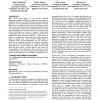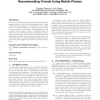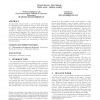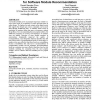RECSYS
2009
ACM
14 years 7 months ago
2009
ACM
To understand users’ acceptance of the emerging trend of personality-based recommenders (PBR), we evaluated an existing PBR using the technology acceptance model (TAM). We also ...
RECSYS
2009
ACM
14 years 9 months ago
2009
ACM
Short search engine queries do not provide contextual information, making it difficult for traditional search engines to understand what users are really requesting. One approach ...
RECSYS
2009
ACM
14 years 9 months ago
2009
ACM
Collaborative Filtering (CF) recommendations are computed by leveraging a historical data set of users’ ratings for items. It assumes that the users’ previously recorded ratin...
RECSYS
2009
ACM
14 years 9 months ago
2009
ACM
We propose FriendSensing, a framework that automatically suggests friends to mobile social-networking users. Using short-range technologies (e.g., Bluetooth) on her mobile phone, ...
RECSYS
2009
ACM
14 years 9 months ago
2009
ACM
Recommender systems based on user feedback rank items by aggregating users’ ratings in order to select those that are ranked highest. Ratings are usually aggregated using a weig...
RECSYS
2009
ACM
14 years 9 months ago
2009
ACM
Besides the rating information, an increasing number of modern recommender systems also allow the users to add personalized tags to the items. Such tagging information may provide...
RECSYS
2009
ACM
14 years 9 months ago
2009
ACM
We propose a novel collaborative recommendation approach to take advantage of the information available in user-created lists. Our approach assumes associations among any two item...
RECSYS
2009
ACM
14 years 9 months ago
2009
ACM
We propose a recommendation technique that works by collecting text descriptions of items and using this textual aura to compute the similarity between items using techniques draw...
RECSYS
2009
ACM
14 years 9 months ago
2009
ACM
Conversation double pivots recommend target items related to a source item, based on co-mentions of source and target items in online forums. We deployed several variants on the d...
RECSYS
2009
ACM
14 years 9 months ago
2009
ACM
Different buyers exhibit different purchasing behaviors. Some rush to purchase new products while others tend to be more cautious, waiting for reviews from people they trust. In...





